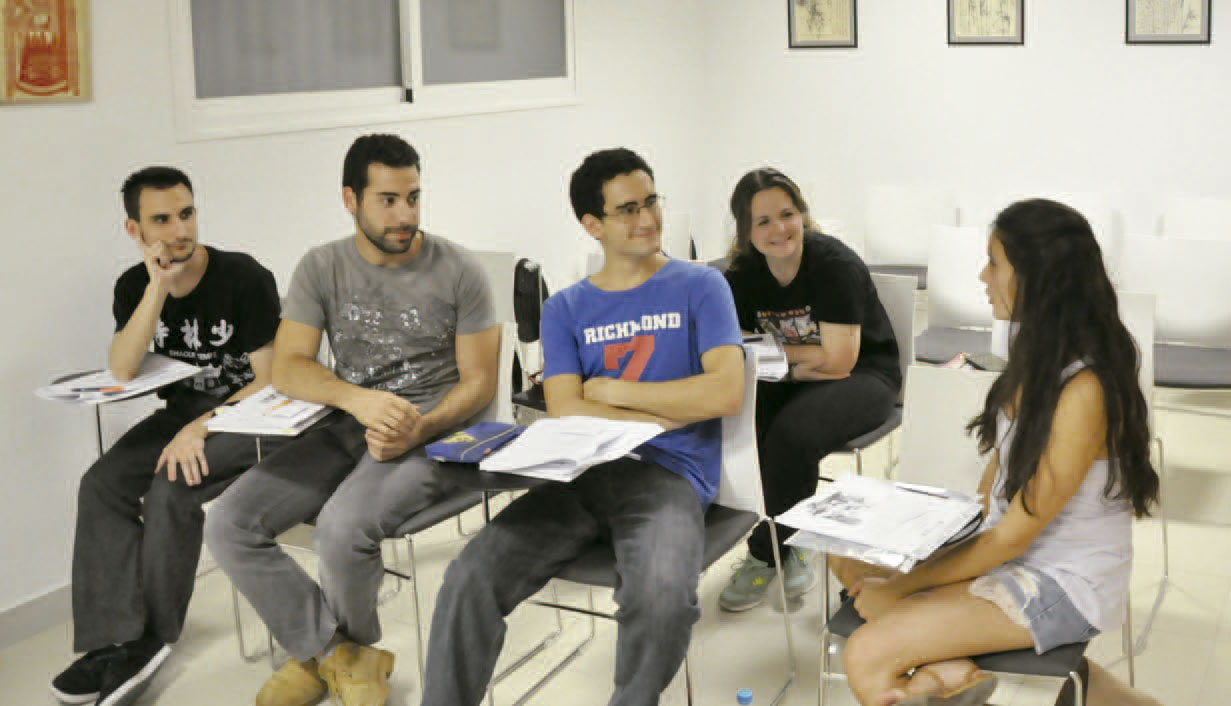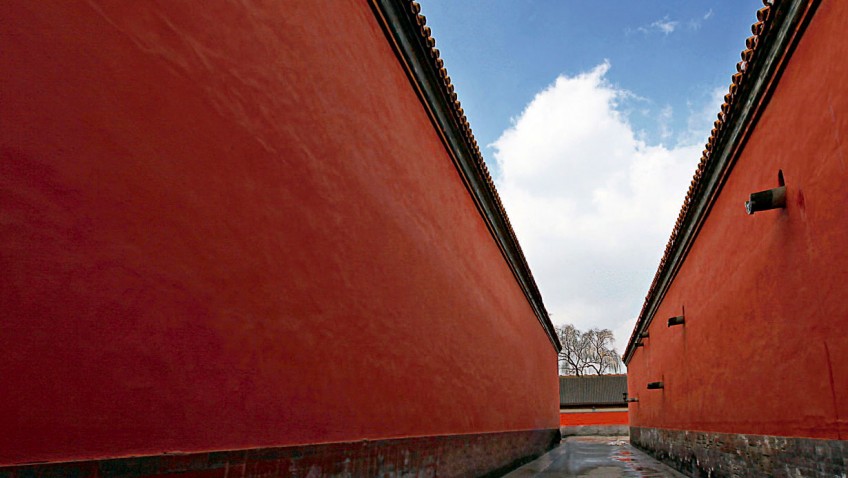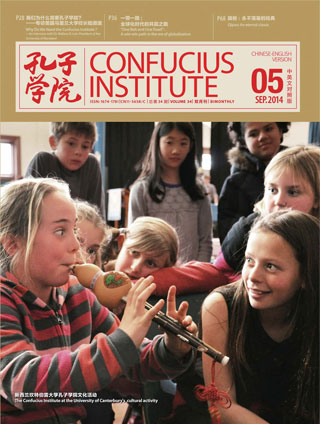Editors’ Note: To tell a story of China to the world, to let the world learn more about China is both the duty and the mission of the Confucius Institute. As a director of a Confucius Institute, it is a challenging job to dispel the unease and misgivings people have when they are faced with a strange culture in a different cultural context and raise their interest in Chinese language and culture. In the 2014 First Workshop for Foreign Directors held not long ago, a number of foreign directors from different Confucius Institutes had lively discussions on the issue of “how to tell a story of China to people around the world”. They shared their views and experiences with each other. The following are some excerpts selected for the readers.
 In intercultural exchanges, we have always stressed on the integration of the static and the dynamic. For instance, we will organize performances, together with exhibitions, lectures, etc. at the same time, in order to achieve the desired effects for cultural dissemination.
In intercultural exchanges, we have always stressed on the integration of the static and the dynamic. For instance, we will organize performances, together with exhibitions, lectures, etc. at the same time, in order to achieve the desired effects for cultural dissemination.Mercedes López Roldán
Director of the Confucius Institute at the University of Granada, Spain
 As a cultural institution, Confucius Institutes play an important role in the dissemination of Chinese culture. However when this is compared to over five thousand years of Chinese history, Chinese culture in reality is not as influential as we imagine. One reason lies in the fact that young adults in China today have an inadequate understanding of the traditional culture. Another reason is that the means of cultural dissemination and promotion are too simple, lacking in the exploration of the rofound cultural connotations.
As a cultural institution, Confucius Institutes play an important role in the dissemination of Chinese culture. However when this is compared to over five thousand years of Chinese history, Chinese culture in reality is not as influential as we imagine. One reason lies in the fact that young adults in China today have an inadequate understanding of the traditional culture. Another reason is that the means of cultural dissemination and promotion are too simple, lacking in the exploration of the rofound cultural connotations.
As we know, “Chinese martial arts”, “acrobatics” and “Beijing opera” are very attractive to foreigners. They represent traditional Chinese culture and may help people around the world have a better understanding of China. But we have to admit that an understanding of Chinese culture based only on such forms is far from enough to move the recipients. After the transient novelty and mystique, they will definitely get more or less tired of those things.
If China wants to promote her culture better, such superficial methods can never fulfill the mission successfully. More emphasis ought to be placed on the profound cultural connotations when leading foreigners to pay more attention to the depths of Chinese culture, such as ethics and morality, values and societal principles, etc. Meanwhile, we have to create new forms of cultural dissemination. Only in this way, can we add new colors and glamour to Chinese culture.
The promotion of Chinese culture is a long and arduous task. We have to improve the promoting capacity gradually. The Confucius Institute needs to systematically think over the cultural dissemination strategies and follow the appropriate procedures for dissemination.
According to our six years of experiences in running the Confucius Institute, we believe that by integrating individual and independent cultural disseminating activities into a series of influential ones, it will greatly improve their efficiency and effectiveness and the range and depths of the cultural activities will also be significantly enhanced.
Out of these considerations, we have integrated some individual courses, such as calligraphy, traditional Chinese painting, handcraft and tea arts into a series of workshops and lectures which have gained positive feedbacks. Some students even register for two or three lectures in the hope of learning more about China from different perspectives.
Some courses in these workshops involve both theories and practices. For instance, in the course of traditional Chinese painting, teachers will not only teach painting techniques but will also introduce the students to different schools of painting in different historical periods. Comparisons are also made between Chinese and Western paintings so as to help the students gain a deeper understanding of both Chinese culture and Chinese painting.
When we introduce China to people around the world, using a single form of promotion will not be able to meet the demands of the cultural market. Static forms of dissemination such as the cooperation between the press and the media can introduce more cultural connotations to people around the world but they have not received enough attention. Therefore in foreign cultural exchanges, we have always stressed on the integration of the static and the dynamic. For instance, we will publish some works on specific topics at specific times and organize some performances, exhibitions, lectures, etc. to achieve the desired effects for cultural dissemination.
Of course, we have to continuously increase the varieties and diversity in the means of cultural promotion and we need to have more creative ideas in order to strengthen international cultural exchanges and cooperation. Through these creative activities, we can help people around the world have a better understanding of Chinese culture.
 The Confucius Institute has become a window of insight for young Americans curious about China.
The Confucius Institute has become a window of insight for young Americans curious about China.Kun Shi
Director of the Confucius Institute at the University of South Florida, the U.S.
 Teachers and staff working for the Confucius Institutes are often met with challenging questions related to the situations in Tibet and Xinjiang. To answer such questions, we should first understand the diversity and complexity of the Chinese society and cultures.
Teachers and staff working for the Confucius Institutes are often met with challenging questions related to the situations in Tibet and Xinjiang. To answer such questions, we should first understand the diversity and complexity of the Chinese society and cultures.
In the West, people tend to view China as homogeneous. But in fact, things are not that simple. China is a nation of tremendous complexity and diversity. Even among the Han Chinese in southeast China, there are many local dialects and regional cultures. Such diversity is even more pronounced in ethnic minority areas. For instance, the Tibetans have three dialects and their belief systems are quite complex; in addition to the mainstream Tibetan Buddhism (which has four schools), there is also Bön dharma and folk religion. When telling the story from western China, I often introduce such cultural diversity upfront.
People sometimes ask whether Tibet and Xinjiang are part of China. Often CI staff either try to evade the question or answer: “Of course, Xinjiang and Tibet have always been a part of China since ancient times”. However such an answer is not so convincing. As shown on the map of China in The World Factbook produced by the U.S. Central Intelligence Agency, Xinjiang and Tibet are territories within China. That is helpful in answering the question.
Media often reports about the life of and incidents related to Tibetans and Uyghur. Readers and viewers may believe these are the only ethnic minority groups in China. In fact, the largest minority group is the Zhuang, with a population of 17 million. Although the Tibetan population has grown significantly (from 2 million in 1964 to over 6 million in 2010), it is still smaller than that of the Tujia, Yi, or Miao groups. The Uyghur population also has grown tremendously (from 3.6 million in 1953 to 10 million in 2010), but it is still smaller than that of the Hui Muslims spreading all over China. However, there is no comparable challenge from the other minority groups. This is because these minority groups have co-existed with the Han majority for a long time, and they share similar belief systems such as Buddhism and Daoism. Therefore, the challenges are often caused by language and religious differences among peoples. Finally, while producing enormous benefits, the globalization process also created many challenges, including and conflicts caused by the rapid mingling of ethnic cultures in the process of economic development.
Josephine Dzahene-Quarshie
Director of the Confucius Institute at the University of Ghana, Ghana
If you ask someone today: is it necessary to know more about China? The answer may very likely be positive. However, some people still have some negative notions. They are suspicious about the reasons in learning Chinese and the motivation behind the establishment of the Confucius Institute. Someone once said to me that since Confucius Institutes have the backing of the Chinese government, definitely there must be some political intentions behind it. As a director of the Confucius Institute, what I can do is to try and clear all sorts of suspicions and doubts that people have about China and let them know that the reasons for teaching is to give people the opportunity to appreciate the Chinese language and culture.
I have always told my friends that it is a big plus to learn a new language and it is a bigger one to learn two. Even if the language is spoken by only ten people, it is still a plus to you. Today, about one-sixth of the world population speak Chinese, which means that one out of six people can speak Chinese and that if you happen to one of those, you will be able to communicate with a wide range of people. Learning Chinese is a good idea and a good choice of language to learn, especially, since it is spoken by such a great number of people. Of course, you can’t just learn Chinese and be unwilling to understand Chinese culture. They are closely related. In the process of learning and understanding, friendships will be enhanced and cooperation will be broadened by way of communication. This is the function of Confucius Institutes.
 Excellent teachers guarantee high-quality teaching.
Excellent teachers guarantee high-quality teaching.Grace Poizat-Xie
Vice-Director of the Confucius Institute at the University of Geneva, Switzerland
 How does the Confucius Institute tell the world about China? There are mainly three ways. The most important one is to let the world come to know and then learn more about China through a series of high-level international academic seminars and an in-depth comparative study of some specific topics. The second one is to introduce to people at all levels and in all trades Chinese language and culture. The third one is to bring China to the attention of Swiss people and foreigners staying in Switzerland through different forms of communication.
How does the Confucius Institute tell the world about China? There are mainly three ways. The most important one is to let the world come to know and then learn more about China through a series of high-level international academic seminars and an in-depth comparative study of some specific topics. The second one is to introduce to people at all levels and in all trades Chinese language and culture. The third one is to bring China to the attention of Swiss people and foreigners staying in Switzerland through different forms of communication.
In the case of international seminars, we will get in touch with every school and departments of the university to ensure that there are experts, in the topics to be discussed, who can work together with us in holding the seminars. For example, with the Renmin University, Harvard University, the University of Sydney we have hosted the “Property Law in Four Dimensions”; we also held Criminal Law Face to Economic and Financial Crimes in China and Switzerland, Chinese Taoist Music, Science and Sociology, Religious Diversity and the History of Religions, Communication and Spreading of Medical Knowledge in Chinese and the West, Geometry, Quantun Topology & Asymptotics, etc. These international academic activities produced widespread impact in academia.
In terms of popularizing Chinese language and culture, we have offered a Public Chinese course. As a result, Chinese, a language formerly possible only to Chinese majors, is made accessible to all, staff and students alike, in the Frenchspeaking region. And they can get credits for the course. As we need more Chinese teachers to work for the Confucius Institute, we have provided trainings in this regard. In less than three years, we provided trainings for Chinese teachers and held seminars on Chinese teaching three times respectively. On every occasion, it had attracted teachers from all over Switzerland to participate in it.
Interactive activities are generally short, approximately several hours to half a day. For this reason, they can be held more frequently. For example, in the year 2012, we joined in the yearly large-scale occupational experience for middle school students and pupils. The Confucius Institute set up special exhibition booths, which enabled Swiss youths to have personal experience with Chinese movies and Chinese music. In 2013, the annual Swiss Collegiate Presidential Conference was held in the Confucius Institute. We took the opportunity to introduce our work and future plans to these presidents from all over Switzerland. They were very interested. We also gave lectures on Chinese culture in banks and big companies. We have actively helped the Geneva governments solve problems related to China. All these efforts help to set up an honorable reputation and image for the Confucius Institute.
 To younger audience, our program should be highly interactive. We may also involve the whole family in such interactions.
To younger audience, our program should be highly interactive. We may also involve the whole family in such interactions.Wei Hong
Director of the Confucius Institute at the University of Purdue, the U.S.
 As a director of the Confucius Institute, I’m devoted to introducing China to the world. The question rises as to what are to be taken into consideration in such an Introduction?
As a director of the Confucius Institute, I’m devoted to introducing China to the world. The question rises as to what are to be taken into consideration in such an Introduction?
There are just too many things to introduce when it comes to Chinese language and culture. We should not repeat the same things over and over again. Instead, we should design our lectures and focus according to the needs of different audiences. For example, for those who would like to do business in China, we can talk about the business culture and etiquette in China, the investment regulations and areas to invest in; to administrators and faculty members in colleges, basic introduction of the Chinese educational system and information on K-12 system will be practical; to younger audience, our program should be highly interactive. We may design interactive activities including games, quiz bowls or role-playing. We may also involve the whole family in such interactions; Government officials, on the other hand, may be interested in hearing more about China’s economic development and the current affairs in China. What young people are up to and what is happening in China in all aspects may be appealing to those in the media.
In addition, to eliminate possible misunderstanding about China and maximize the communication across all cultures, we should consider strategies to present China in a natural and acceptable way. Before your presentations, make sure that you, as the presenter, best understand the topic to be presented, to avoid superficial and naive coverage. Extensive reading in Chinese history, literature, politics, economics and geography only adds the maturity of your presentations. The point is, the presenters would need to be equipped well with local language and culture before they can comfortably present about China.
Published in Confucius Institute Magazine
Number 34. Volume V. September 2014.



You need to be a member of Iconada.tv 愛墾 網 to add comments!
Join Iconada.tv 愛墾 網